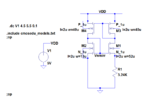aravind2705
Newbie level 1

For example, in the Beta-Multiplier circuit I have attached here, when I sweep the VDD, the VSD of M4 increases at a higher rate than does the VGS of M2.
Also, the gate of M3 follows VDD and keeps VSG constant. Why does this happen, Why is the gate-source voltage of a diode-connected transistor magically supply-independent (in the large-signal domain) ??
Image: https://obrazki.elektroda.pl/84_1325303679.png